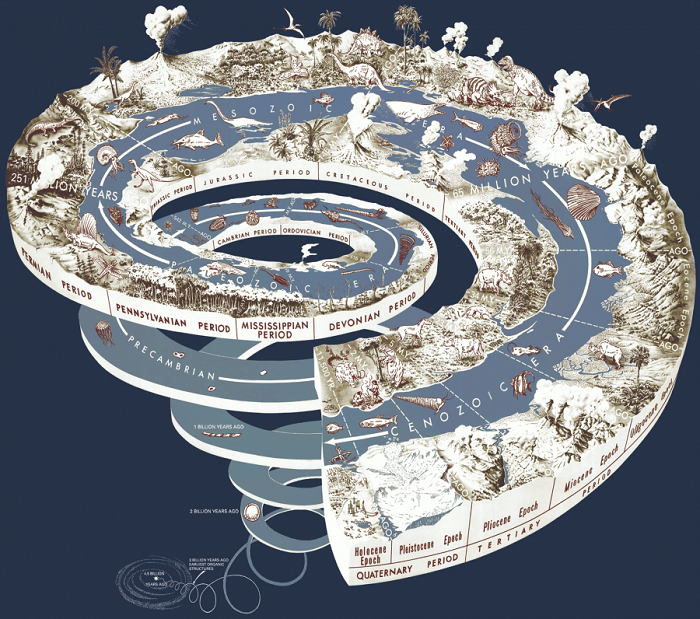The Silurian Hypothesis, inspired by science fiction, challenges our assumptions about the past. Could advanced civilizations have existed on Earth millions of years before humanity? This thought-provoking concept compels us to explore the possibility of lost civilizations and rethink how we search for evidence of ancient life.
Introduction to the Silurian Hypothesis
In the quest to comprehend the enigmatic past of our planet, scientists have proposed intriguing theories that challenge our conventional understanding of ancient civilizations. One such captivating concept is “The Silurian Hypothesis.” This hypothesis posits the tantalizing notion that we might not be the first advanced civilization to inhabit Earth.
But what exactly is “The Silurian Hypothesis”? At its core, it challenges the assumption of human primacy in the annals of history. Inspired by the science fiction series Doctor Who, the term “Silurian” refers to intelligent humanoid reptilians who, according to the show, went into hibernation for 400 million years and were later awakened by nuclear testing. While the lizard people aspect is fictional, the hypothesis itself delves into the possibility of advanced civilizations predating humanity.
To grasp the essence of this hypothesis, we must confront our own temporal biases. Humans tend to perceive time through the lens of our brief existence on Earth, overlooking the vast epochs that preceded us. Consider this: modern humans have roamed the Earth for merely 0.002 percent of its entire history. In this expansive timeline, there exists ample opportunity for other intelligent species to have risen, thrived, and vanished, leaving scant traces for us to discover.
The Silurian Hypothesis challenges us to rethink our approach to archaeology and the study of ancient civilizations. Traditional methods, reliant on excavating artifacts and ruins, may prove insufficient when delving into epochs millions of years in the past. Factors such as plate tectonics and the rarity of fossilization further obscure our ability to detect traces of past civilizations.
In the subsequent sections of this article, we’ll delve deeper into the challenges and potential implications of The Silurian Hypothesis, exploring how it reshapes our understanding of Earth’s history and its relevance in the search for extraterrestrial life. For more fascinating insights and discussions on topics like these, visit our website “Mystery Uncover“.
Challenges in Detecting Ancient Civilizations

As we embark on a journey to unravel the mysteries of our planet’s past, we encounter formidable challenges that hinder our quest to uncover evidence of ancient civilizations. Central to this endeavor is the enigmatic concept known as “The Silurian Hypothesis,” which posits the existence of advanced societies that thrived long before the advent of humanity.
One of the primary obstacles in detecting ancient civilizations lies in our limited understanding of deep time. While human civilization spans a mere fraction of Earth’s history, the epochs preceding our existence stretch back millions of years. This vast temporal expanse presents a daunting task for archaeologists, as traditional methods of excavation and artifact analysis may prove inadequate when exploring epochs millions of years in the past.
Moreover, the dynamic nature of Earth’s geology further complicates our efforts. Plate tectonics continually reshape the planet’s surface, obscuring or destroying potential evidence of past civilizations. Landmasses that once harbored thriving societies may have been subsumed by the relentless forces of erosion and subduction, leaving behind scant traces for us to discover.
The rarity of fossilization poses another significant challenge in our quest to detect ancient civilizations. Fossilization requires precise conditions, including the rapid burial and preservation of organic materials. Yet, these conditions are seldom met, resulting in the scarcity of fossilized remains that could offer insights into past civilizations.
Furthermore, the ephemeral nature of human artifacts compounds the difficulty of detection. Unlike durable materials such as stone, metal, and ceramics, many of our modern constructions and technologies are transient, destined to decay or be reclaimed by nature over time.
Evidence from Industrialization and Sedimentary Layers
In our pursuit to unravel the secrets of ancient civilizations, scientists are turning to unconventional sources of evidence that transcend the limitations of traditional archaeological methods.
Central to this endeavor is “The Silurian Hypothesis,” a thought-provoking concept that challenges our perceptions of Earth’s history. As we delve deeper into this hypothesis, we uncover compelling evidence from industrialization and sedimentary layers that offer tantalizing clues about civilizations that may have preceded our own.
Industrialization, with its global-scale impact on the environment, leaves behind a footprint that transcends time. The activities of modern civilization, from agriculture to mining, alter the composition of the Earth’s atmosphere and leave discernible traces in sedimentary layers. These layers, deposited over millions of years, serve as a repository of Earth’s history, capturing the subtle shifts and upheavals wrought by human activity.
One of the most significant indicators of industrialization is the alteration of isotopic signatures within sedimentary layers. Through processes such as nitrogen cycling and combustion of fossil fuels, human activities leave behind distinctive isotopic markers that persist over geological time scales. These markers, detectable through meticulous analysis of sedimentary cores, provide invaluable insights into the presence and impact of past civilizations.
Furthermore, the accumulation of anthropogenic materials, such as metals and pollutants, within sedimentary layers offers tangible evidence of human influence on the environment. From increased concentrations of gold and platinum to the proliferation of carbon emissions, these signatures paint a vivid picture of the industrial activities that have shaped our planet’s history.
By harnessing the power of sedimentary analysis, scientists are beginning to unravel the complex tapestry of Earth’s past, shedding light on the possibility of ancient civilizations that existed long before our own.
The PETM Event: Possible Evidence?
In the labyrinth of Earth’s history, one enigmatic event stands out as a potential piece of evidence in the puzzle of ancient civilizations: the Paleocene-Eocene Thermal Maximum (PETM). This pivotal moment, which occurred approximately 56 million years ago, has garnered attention from scientists exploring “The Silurian Hypothesis” – a concept that challenges our assumptions about the timeline of advanced civilizations on Earth.
During the PETM, Earth experienced a dramatic shift in climate, marked by a sudden increase in global temperatures and profound changes to the environment. The event, which lasted for approximately 200,000 years, saw temperatures rise by as much as six degrees Celsius, leading to the disappearance of polar ice caps and significant alterations to ecosystems worldwide.
But what makes the PETM particularly intriguing in the context of The Silurian Hypothesis is the possibility that it could be indicative of an advanced civilization predating humanity. The rapid and unprecedented nature of climate change during this period raises questions about its potential causes – questions that extend beyond natural phenomena such as volcanic eruptions or asteroid impacts.
Some proponents of The Silurian Hypothesis speculate that the PETM may have been triggered by human-like activities, such as widespread industrialization or environmental manipulation. While such theories remain speculative, they underscore the importance of considering alternative explanations when exploring Earth’s ancient past.
However, it’s essential to approach these hypotheses with a critical eye. While the PETM offers tantalizing clues about Earth’s distant history, conclusive evidence linking it to ancient civilizations remains elusive. As scientists continue to unravel the mysteries of the past, the PETM stands as a reminder of the complexities and uncertainties inherent in our quest to understand the origins of life on Earth.
Other Hypothetical Ancient Civilizations
While “The Silurian Hypothesis” offers a captivating glimpse into the possibility of ancient civilizations preceding our own, it’s not the only theory that challenges our understanding of Earth’s history. Delving deeper into the annals of time, scientists have proposed various hypotheses that contemplate the existence of other ancient civilizations, each with its own unique implications and mysteries.
One such hypothesis revolves around major global events that may have obscured evidence of past civilizations. Throughout Earth’s tumultuous history, cataclysmic events such as asteroid impacts, volcanic eruptions, and shifts in climate have reshaped the planet’s surface and dramatically altered its ecosystems. These events, while devastating in their immediate impact, have the potential to erase traces of advanced societies, leaving behind only faint echoes in the geological record.
For instance, the Cretaceous period witnessed events that depleted the Earth’s oceans of oxygen for thousands of years, posing significant challenges to marine life and potentially disrupting the development of advanced civilizations. Similarly, the Eocene Layers of Mysterious Origins and other enigmatic geological phenomena hint at the possibility of ancient civilizations that flourished and vanished in the mists of time.
While the existence of these hypothetical ancient civilizations remains speculative, they underscore the complexities of Earth’s history and the myriad factors that shape the evolution of life on our planet. As we continue to probe the depths of time, it’s essential to consider alternative explanations and remain open to new discoveries that may challenge our preconceptions.
Implications for Extraterrestrial Civilizations
While “The Silurian Hypothesis” prompts us to rethink our understanding of ancient civilizations on Earth, its implications extend far beyond our planet’s borders, igniting speculation about the existence of intelligent life elsewhere in the universe. This hypothesis opens a gateway to exploration, offering insights into the potential prevalence and diversity of extraterrestrial civilizations.
Central to The Silurian Hypothesis is the notion that if advanced civilizations could have arisen on Earth before humanity, then similar civilizations could have emerged on other planets throughout the cosmos. This tantalizing prospect fuels the imagination, prompting us to ponder the possibility of encountering intelligent beings on distant worlds.
The Drake Equation, a renowned formula for estimating the number of extraterrestrial civilizations in our galaxy, takes on new significance in light of The Silurian Hypothesis. By considering factors such as the number of stars with planets and the likelihood of those planets developing intelligent life, the equation offers a framework for contemplating the potential abundance of civilizations beyond Earth.
Moreover, The Silurian Hypothesis provides valuable insights into the search for extraterrestrial life. By examining Earth’s geological record and considering the conditions that may have fostered ancient civilizations, scientists can refine their search strategies and target promising candidates for exploration.
As we venture further into the cosmos, armed with The Silurian Hypothesis as a guide, we may uncover evidence of civilizations that have risen, flourished, and perhaps vanished on distant planets. This journey of discovery not only enhances our understanding of the universe but also raises profound questions about humanity’s place within it.
Frequently Asked Questions (FAQs)
1. What is the Silurian Hypothesis?
The Silurian Hypothesis proposes that advanced civilizations may have existed on Earth prior to humanity. Inspired by science fiction, it challenges the assumption of human primacy in history and prompts us to reconsider our understanding of ancient civilizations.
2. How does the Silurian Hypothesis affect archaeology?
The Silurian Hypothesis challenges traditional archaeological methods by suggesting that evidence of ancient civilizations may be obscured by geological processes and the rarity of fossilization. It encourages a reevaluation of how we approach the study of deep time and ancient cultures.
3. What evidence supports the Silurian Hypothesis?
Evidence from industrialization and sedimentary layers offers clues about past civilizations. Isotopic markers, anthropogenic materials, and alterations in sedimentary layers provide insights into the presence and impact of ancient societies that existed long before our own.
4. Could events like the PETM be linked to ancient civilizations?
The Paleocene-Eocene Thermal Maximum (PETM) and other enigmatic events raise questions about their potential causes. While some speculate that human-like activities triggered these events, conclusive evidence linking them to ancient civilizations remains elusive.
5. What are the implications of the Silurian Hypothesis for extraterrestrial civilizations?
The Silurian Hypothesis prompts us to consider the possibility of intelligent life beyond Earth. By exploring Earth’s history and conditions that may have fostered ancient civilizations, scientists refine their search strategies for detecting extraterrestrial civilizations, enhancing our understanding of the universe.






